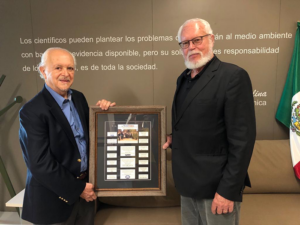
Through his brilliant science and tireless advocacy, Dr. Mario Molina helped the world successfully respond to the first global environmental crisis, the threat of chlorofluorocarbons (CFC) to the planet’s protective ozone shield. He shared the 1995 Nobel Prize in Chemistry for his role in discovering this threat.

Sadly, Dr. Molina left us on October 7, 2020. But he did not leave us empty-handed. A true gentleman and optimist, Mario not only set us on the path to environmental stewardship and justice, he left us a roadmap for how to solve climate change in time to prevent climate chaos.
In 2009, Mario co-authored a paper in the Proceedings of the National Academy of Sciences titled Reducing abrupt climate change risk using the Montreal Protocol and other regulatory actions to complement cuts in CO2 emissions. This paper set out the first roadmap for fast mitigation under the Montreal Protocol on Substances that Deplete the Ozone Layer and other venues to solve the next great threat to the global environment, climate change. Just as he had for the Montreal Protocol, Mario worked hard behind the scenes on what became the Kigali Amendment, agreed in 2016. By taking on the super-greenhouse gas hydrofluorocarbons (HFCs) that replaced the ozone-depleting CFC and HCFC, which were also strong greenhouse gases, the Kigali Amendment cements the Montreal Protocol as the most impactful climate change treaty.
The Kigali Amendment also recognized the importance of ensuring a transition to climate-friendly and energy-efficient cooling equipment. And Mario co-chaired the steering committee on the UNEP and IEA Cooling Emissions and Policy Synthesis Report, which showed that the combined strategy to improve energy efficiency of cooling equipment while phasing down HFC refrigerants under the Kigali Amendment to the Montreal Protocol is one of the biggest mitigation opportunities available today.
Mario was hard at work updating that 2009 paper to show how close the world is to a catastrophic hothouse, and how we can use the Montreal Protocol to prevent this by cutting the short-lived climate pollutants and protecting our carbon sinks. He promoted the need for speed to slow feedbacks and avoid tipping points:
“And let us be clear: By “speed,” we mean measures—including regulatory ones—that can begin within two-to-three years, be substantially implemented in five-to-10 years, and produce a climate response within the next decade or two.”
We’re the ones who have to carry on. But we have his roadmap and his reminder of the need for speed.
###
To learn more, check out Living on Earth’s story about Dr. Molina’s remarkable life and contributions.
